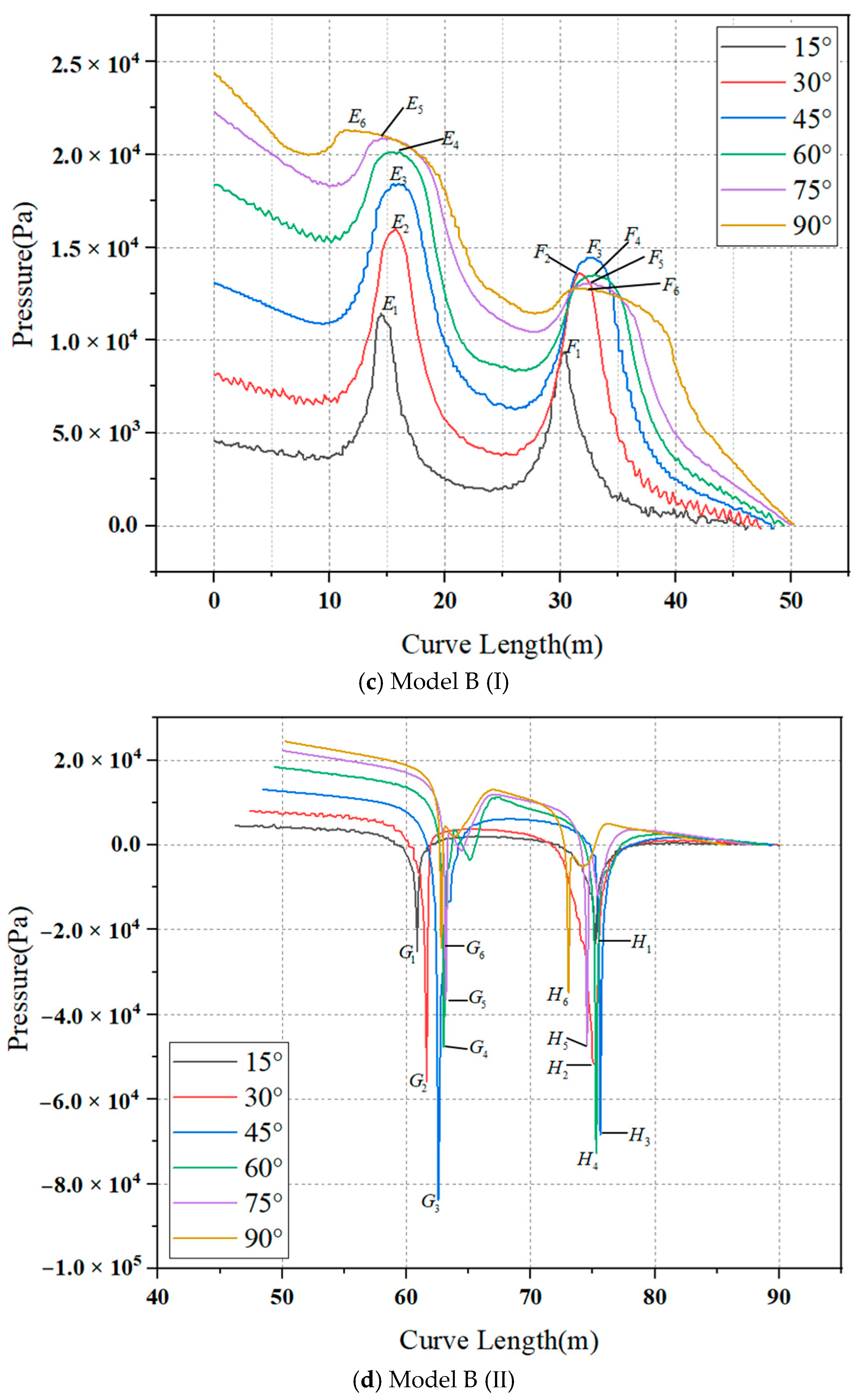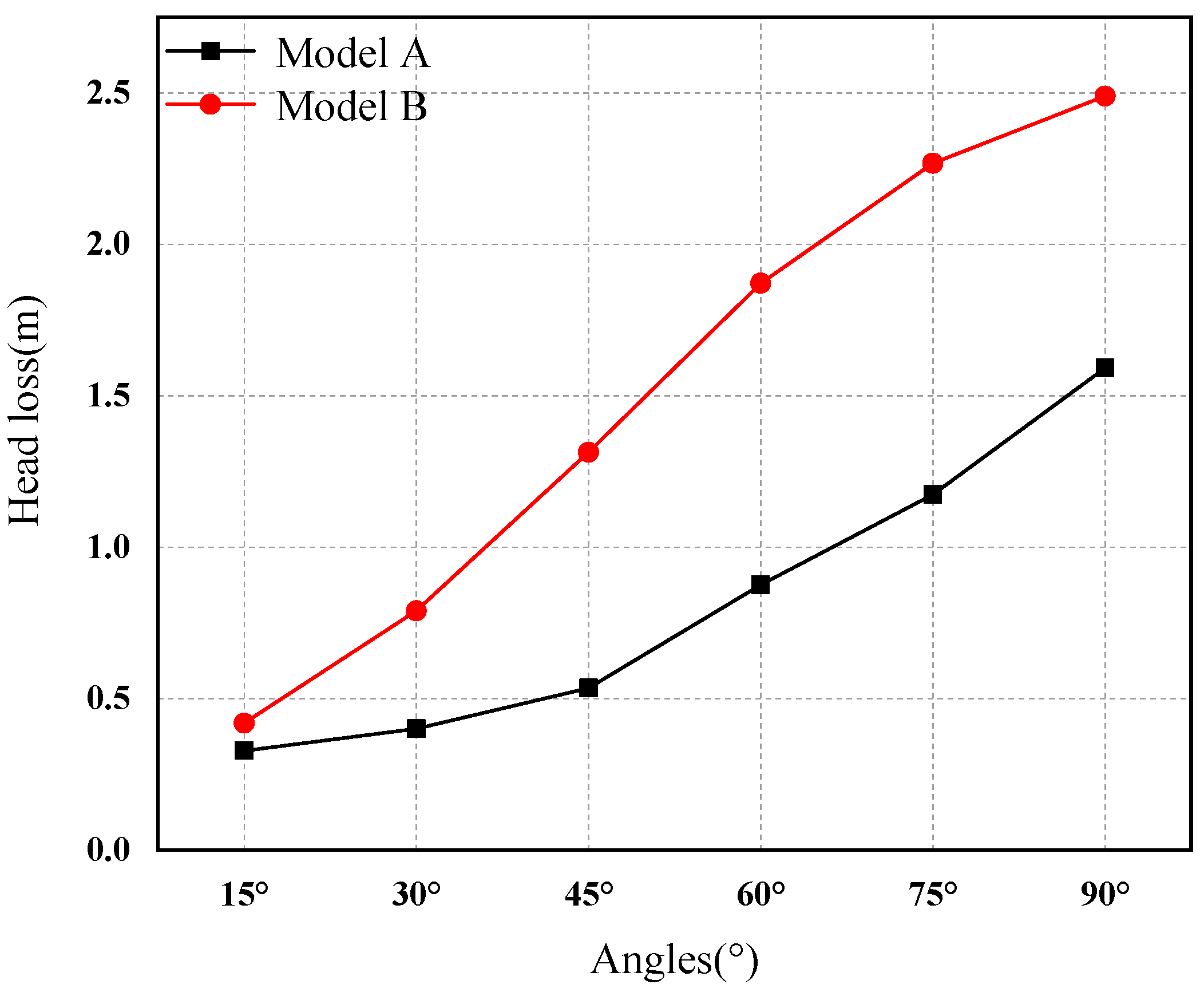Hydraulic Characteristics Analysis of Double-Bend Roadway of Abandoned Mine Pumped Storage
Abstract
:1. Introduction
2. Numerical Model of the Double-Bend Roadway in Abandoned Mine
2.1. The Establishment of the Geometric Model
2.2. Governing Equation
2.3. Model Solution Setup
3. Results and Analysis
3.1. The Velocity Field Analysis of the Double-Bend Roadway
3.2. The Pressure Field Analysis of the Double-Bend Roadway
3.3. The Pressure Analysis along the Line
3.4. Energy Loss
4. Feasibility Analysis of Abandoned Mine Pumped Storage
5. Conclusions
Author Contributions
Funding
Institutional Review Board Statement
Informed Consent Statement
Data Availability Statement
Conflicts of Interest
References
- Sun, W.J.; Ren, S.L.; Wu, Q.; Dong, D.L.; Gan, X.Y. Waterpollution’s prevention and comprehensive utilization of abandoned coal mines in China under the new normal life. J. China Coal Soc. 2022, 47, 2161–2169. [Google Scholar]
- Sun, Y.J.; Xu, Z.M.; Li, X.; Zhang, L.; Chen, G.; Zhao, X.M.; Gao, Y.T.; Liu, Q.; Zhang, S.G.; Wang, W.J.; et al. Mine water drainage pollution in China’s coal mining areas and the construction of prevention and control technical system. Coal Geol. Explor. 2021, 49, 1–16. [Google Scholar]
- Yuan, L.; Jiang, Y.D.; Wang, K.; Zhao, Y.X.; Hao, X.J.; Xu, C. Precision exploitation and utilization of closed/abandoned mine resources in China. J. China Coal Soc. 2018, 43, 14–20. [Google Scholar]
- Xie, H.P.; Wu, L.X.; Zheng, D.Z. Prediction on the energy consumption and coal demand of China in 2025. J. China Coal Soc. 2019, 44, 1949–1960. [Google Scholar]
- Yuan, L.; Yang, K. Further discussion on the scientific problems and countermeasures in the utilization of abandoned mines. J. China Coal Soc. 2021, 46, 16–24. [Google Scholar]
- Yuan, L. Scientific conception of precision coal mining. J. China Coal Soc. 2017, 42, 1–7. [Google Scholar]
- Yuan, L. Strategic thinking of simultaneous exploitation of coal and gas in deep mining. J. China Coal Soc. 2016, 41, 1–6. [Google Scholar]
- Wang, S.M.; Shen, Y.J.; Sun, Q.; Liu, L.; Shi, Q.M.; Zhu, M.B.; Zhang, B.; Cui, S.D. Underground CO2 storage and technical problems in coal mining area under the “dual carbon” target. J. China Coal Soc. 2022, 47, 45–60. [Google Scholar]
- Yuan, L.; Zhang, T.; Zhang, Q.H.; Jiang, B.Y.; Lü, X.; Li, S.S.; Fu, Q. Construction of green, low-green and multi-energy completmentary system for abandoned mines under global carbon neutrality. J. China Coal Soc. 2022, 47, 2131–2139. [Google Scholar]
- Xie, H.P.; Gao, M.Z.; Gao, F.; Zhang, R.; Ju, Y.; Xu, H.; Wang, Y.W. Strategic conceptualization and key technology for the transformation and upgrading of shut-down coal mines. J. China Coal Soc. 2017, 42, 1355–1365. [Google Scholar]
- Xie, H.P.; Gao, M.Z.; Liu, J.Z.; Zhou, H.W.; Zhang, R.X.; Chen, P.P.; Liu, Z.Q.; Zhang, A.L. Research on exploitation and volume estimation of underground space in coal mines. J. China Coal Soc. 2018, 43, 1487–1503. [Google Scholar]
- Xie, H.P.; Hou, Z.M.; Gao, F.; Zhou, L.; Gao, Y.N. A new technology of pumped-storage power in underground coal mine: Principles, present situation and future. J. China Coal Soc. 2015, 40, 965–972. [Google Scholar]
- Bian, Z.F.; Zhou, Y.J.; Zeng, C.L.; Huang, J.; Pu, H.; Axel, P.; Zhang, B.S.; Habil, C.B.; Bai, H.B.; Meng, Q.B.; et al. Discussion of the basic problems for the construction of under-ground pumped storage reservoir in abandoned coal mines. J. China Coal Soc. 2021, 46, 3308–3318. [Google Scholar]
- Nzotcha, U.; Kenfack, J.; Manjia, M.B. Integrated multi-criteria decision making methodology for pumped hydro-energy storage plant site selection from a sustainable development perspective with an application. Renew. Sustain. Energy Rev. 2019, 112, 930–947. [Google Scholar] [CrossRef]
- Kitsikoudis, V.; Archambeau, P.; Dewals, B.; Pujades, E.; Orban, P.; Dassargues, A.; Pirotton, M.; Erpicum, S. Underground Pumped-Storage Hydropower (UPSH) at the Martelange Mine (Belgium): Underground Reservoir Hydraulics. Energies. 2020, 13, 3512. [Google Scholar] [CrossRef]
- Wang, B.; Liu, P.S.; Deng, K.L. Site selection of pumped storage power station in abandoned mines: Results from fuzzy-based multi criteria decision model. J. Min. Sci. Technol. 2021, 6, 667–677. [Google Scholar] [CrossRef]
- Zhu, C.B.; Zhou, Y.J.; Bian, Z.F.; Chen, N.; Xia, C.Y.; Bai, H.B. Topological model construction and space optimization of abandoned mine pumped storage from the perspective of space syntax. J. China Coal Soc. 2022, 47, 2279–2288. [Google Scholar]
- Menéndez, J.; Loredo, J.; Galdo, M.; Fernandez-Oro, J.M. Energy storage in underground coal mines in NW Spain: Assessment of an underground lower water reservoir and preliminary energy balance. Renew. Energy 2019, 134, 1381–1391. [Google Scholar] [CrossRef]
- Menéndez, J.; Fernandez-Oro, J.M.; Galdo, M.; Loredo, J. Transient Simulation of Underground Pumped Storage Hydropower Plants Operating in Pumping Mode. Energies 2020, 13, 1781. [Google Scholar] [CrossRef] [Green Version]
- Menéndez, J.; Fernandez-Oro, J.M.; Galdo, M.; Loredo, J. Pumped-storage hydropower plants with underground reservoir: Influence of air pressure on the efficiency of the Francis turbine and energy production. Renew. Energy 2019, 143, 1427–1438. [Google Scholar] [CrossRef]
- Pujades, E.; Orban, P.; Archambeau, P.; Kitsikoudis, V.; Erpicum, S.; Dassargues, A. Underground Pumped-Storage Hydropower (UPSH) at the Martelange Mine (Belgium): Interactions with Groundwater Flow. Energies 2020, 13, 2353. [Google Scholar] [CrossRef]
- Brouyère, S.; Orban, P.; Wildemeersch, S.; Couturier, J.; Gardin, N.; Dassargues, A. The Hybrid Finite Element Mixing Cell Method: A New Flexible Method for Modelling Mine Ground Water Problems. Mine Water Environ. 2009, 28, 102–114. [Google Scholar] [CrossRef] [Green Version]
- Wildemeersch, S.; Brouyère, S.; Orban, P.; Couturier, J.; Dingelstadt, C.; Veschkens, M.; Dassargues, A. Application of the Hybrid Finite Element Mixing Cell method to an abandoned coalfield in Belgium. J. Hydrol. 2010, 392, 188–200. [Google Scholar] [CrossRef] [Green Version]
- Ye, P. Fluid Dynamics Analysis and Structural Optimization Design of Underground Pumped-Storage Power Station in Abandoned Coal Mine. Master’s Thesis, China University of Mining and Technology, Xuzhou, China, 2020. [Google Scholar]
- Rudakov, D.; Westermann, S. Analytical modeling of mine water rebound: Three case studies in closed hard-coal mines in Germany. Min. Miner. Depos. 2021, 15, 22–30. [Google Scholar] [CrossRef]









Disclaimer/Publisher’s Note: The statements, opinions and data contained in all publications are solely those of the individual author(s) and contributor(s) and not of MDPI and/or the editor(s). MDPI and/or the editor(s) disclaim responsibility for any injury to people or property resulting from any ideas, methods, instructions or products referred to in the content. |
© 2023 by the authors. Licensee MDPI, Basel, Switzerland. This article is an open access article distributed under the terms and conditions of the Creative Commons Attribution (CC BY) license (https://creativecommons.org/licenses/by/4.0/).
Share and Cite
Zhou, X.; Zhou, Y.; Xu, X.; Zeng, C.; Zhu, C. Hydraulic Characteristics Analysis of Double-Bend Roadway of Abandoned Mine Pumped Storage. Sustainability 2023, 15, 3958. https://doi.org/10.3390/su15053958
Zhou X, Zhou Y, Xu X, Zeng C, Zhu C. Hydraulic Characteristics Analysis of Double-Bend Roadway of Abandoned Mine Pumped Storage. Sustainability. 2023; 15(5):3958. https://doi.org/10.3390/su15053958
Chicago/Turabian StyleZhou, Xin, Yuejin Zhou, Xiaoding Xu, Chunlin Zeng, and Chaobin Zhu. 2023. "Hydraulic Characteristics Analysis of Double-Bend Roadway of Abandoned Mine Pumped Storage" Sustainability 15, no. 5: 3958. https://doi.org/10.3390/su15053958





